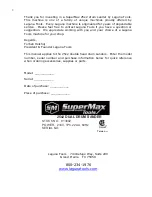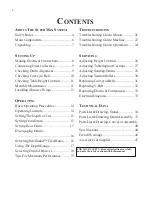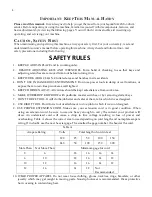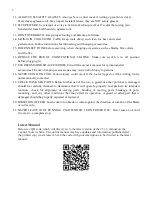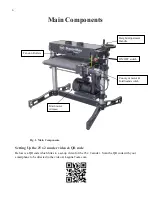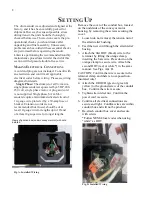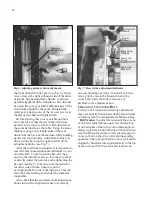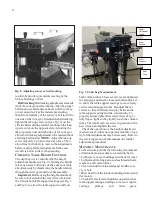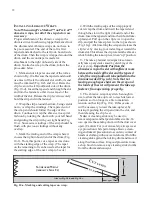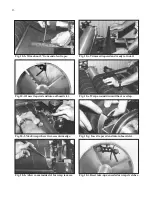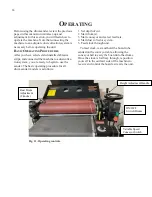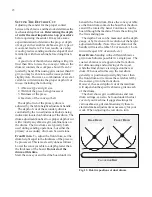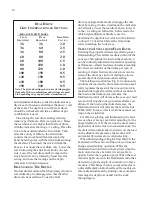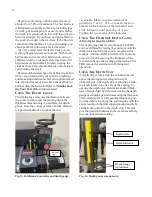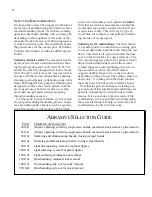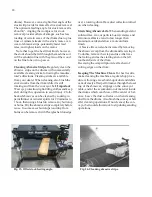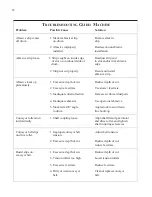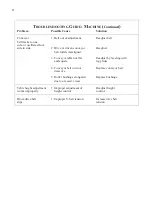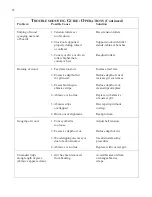
11
T
AKE
-
UP
S
CREW
N
UT
Fig. 8. Adjusting conveyor belt tracking.
result in bent rollers, premature wearing of the
bronze bushings or belt.
Belt Tracking
. Belt tracking adjustments are made
while the conveyor belt is running. After the proper
belt tension is obtained (see above), turn the convey-
or unit on and set it at the fastest speed setting.
Watch for a tendency of the conveyor belt to drift to
one side of the conveyor. To adjust the belt tracking,
tighten the take-up screw nut (see Fig. 8) on the
side the belt is drifting toward, and loosen the take-
up screw nut on the opposite side. Adjusting the
take-up screw nuts on both sides of the conveyor
allows belt tracking adjustments to be made without
affecting belt tension.
NOTE:
Adjust the take-up
screw nuts only 1/4 turn (or less) at a time. Then
allow time for the belt to react to the adjustments
before making further adjustments.
Make sure
wrench is below surface when sanding.
C
HECKING
T
ABLE
H
EIGHT
C
ONTROLS
The depth of cut is controlled by the height
adjustment handle (see Fig. 9). Turning the handle
raises or lowers both sides of the conveyor table
simultaneously by transferring the handle rotation
through the miter gear and cross bar assembly.
Important
: Before using the height adjustment,
be sure to loosen both of the set screws located on
the front of both table support castings (see Fig. 3
and Fig. 9) to allow the table support to slide on
Fig. 9. Table height adjustment.
both column tubes. These set screws are tightened
for shipping and must be loosened and readjusted
to allow the table support castings to move freely
on the column support tubes. Readjust the set
screws so they eliminate free-play between the
table support casting and the column tube. To
properly adjust, tighten the set screws (see Fig. 3)
only finger- tight so they lightly touch the column
tubes. Then hold each set screw in position with a
hex wrench and tighten the nut.
Check the operation of the height adjustment
mechanism. If it does not operate smoothly or eas-
ily, further adjustments may be necessary. Refer to
the servicing section of this manual, for further
adjustment procedures.
M
ONTHLY
M
AINTENANCE
For best results, perform the following recommend-
ed maintenance procedures on a monthly basis:
•
Lubricate conveyor bushings and check for wear.
•
Lubricate all moving parts, such as threaded rods,
washers, and column tubes.
•
Clean sawdust from the sandpaper and the con-
veyor belt.
•
Blow dust from the inside of sanding drum(s) and
the motors.
•
Check all set screws for tightness on parts such as
table support castings, bearings, conveyor coupler,
castings,
pulleys,
and
miter
gears.
Height
Adjustment
Handle
Drum
Support
Table
Support
Miter
Gears
Summary of Contents for SuperMax 25x2
Page 1: ...OWNERS S MANUAL 25x2 SuperMax Drum Sander LagunaTools com...
Page 36: ...36 STAND ASSEMBLY...
Page 39: ...39 DUAL DRUM HEAD ASSEMBLY...
Page 43: ...43 CONVEYOR MOTOR...
Page 45: ...45 CS DE S CURIT...


